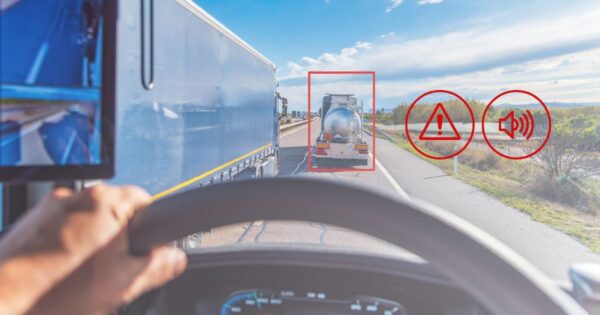Behind every smooth take-off or landing is a network of ground crews working tirelessly to keep things running safely and efficiently. While most attention is directed toward aircraft and air traffic control, the ground operations that support these systems are just as important.
Every day, crews of vehicles and ground staff work in sync to manage aircraft turnaround, refuelling, baggage handling, catering, and maintenance. But one small mistake can cause major delays, costly damage – or, in the worst cases, serious injury or loss of life.
A $4 billion problem facing global aviation
Ground collisions involving airport vehicles, aircraft, and personnel remain a serious safety. Skybrary reports that many aviation-related accidents occur not in the air, but on the ground – where tight spaces, limited visibility, and human error often converge.
Even minor collisions can result in major costs. A single ground vehicle striking an aircraft can cause significant operational and financial disruption. Even low-speed impacts can dent fuselages, damage sensors, or concern compromise critical systems like cargo doors or fuel lines.
And this leads to:
- Flight delays or cancellations, affecting hundreds of passengers and throwing off airline schedules.
- Immediate aircraft inspections or grounding, often required by aviation safety authorities following an incident.
- High repair costs — even superficial damage to composite aircraft materials or control surfaces can cost tens or hundreds of thousands to fix.
- Replacement of specialist parts that may not be readily available on-site, extending downtime.
- Insurance claims and liability issues, particularly when the incident involves third-party contractors.
- Potential regulatory scrutiny or safety investigations from aviation bodies like the FAA, EASA, or local airport authorities.
In fact, The International Air Transport Association (IATA) has estimated the total global cost of ground damage to aircraft at over $4 billion annually — and they have projected that without proactive steps, the annual cost could reach nearly $10 billion by 2035.
In high-stakes environments, we need more than just eyes on the ground
Operating vehicles and machinery on the tarmac presents unique visibility challenges. Ground service vehicles – usually large, boxy, and often customised for specific tasks – come with blind spots like any vehicle. When you also take into poor weather, low light conditions, and constant movement from aircraft and personnel into account, the risks of a collision quickly escalate.
Traditional methods like mirrors and manual spotters can only do so much. People play a vital role in ground safety—but they can’t see everything, all the time. Fatiga, distraction, and the pressure to make quick decisions are inevitable challenges that impact safety.
And in a high-stakes environment, where even a small mistake can lead to significant consequences, human observation alone can no longer be relied upon.
AI-powered sensors: a new horizon
To mitigate these risks, many airports and ground handling operators are turning to advanced technologies, particularly AI-powered cameras and sensors.
AI-powered systems can detect nearby vehicles, machines, aircrafts and operators – and issue real-time alerts to drivers.
Control del conductor technology also plays a key role in ensuring operators stay focused. These systems issue audio alerts in real time if drivers look away from the wheel for even a couple of seconds, or show signs of fatigue, such as yawning or heavy eyes – often the result of long shifts.
Telematics platforms further enhance safety by tracking driver behaviour over time. They can identify dangerous habits, like speeding, sharp turns, or harsh braking, providing valuable insights for ongoing training to reinforce safe driving practices.
This kind of predictive insight enables a shift from reactive to proactive safety, transforming how ground operations are managed.
Think of AI as air traffic control for the ground
Just as controllers guide aircraft safely through crowded skies, AI-powered systems provide real-time oversight of everything moving on the tarmac—from baggage carts and fuel trucks to mobile stair units and personnel. These systems don’t just detect what’s nearby; they and step in with instant alerts when a collision risk appears. The result? Fewer blind spots, faster reactions, and smarter decisions—before incidents can occur.
Beyond safety: enhancing operational efficiency
While safety is the primary driver, technology also brings significant operational benefits. Cargo loading monitored by AI-connected cameras ensures that baggage and freight are handled correctly, reducing damage and speeding up aircraft turnaround.
Interactive digital checklists further streamline this process, providing ground crews with real-time task management for preflight checks, restocking aircraft, and other essential operations. These checklists ensure no steps are missed, enhancing efficiency and accountability across every stage.
Telematics can help manage fleet performance, track vehicle health, and automate maintenance scheduling. These insights reduce wear and tear, prevent breakdowns, and keep ground fleets running smoothly, all while ensuring that maintenance tasks are completed on time, thanks to automated reminders and real-time alerts.
This combination of AI, telematics, and digital checklists adds another layer of efficiency to airport operations.
Transforming airport ground operations with technology
Airport ground operations are critical to flight safety and punctuality, but they come with their own set of challenges. As airports get busier, traditional safety methods are proving insufficient. AI-powered sensors and technology offer a practical solution, not just by improving visibility but by predicting and preventing potential issues before they happen.
By adopting AI-driven systems, airports can better manage risks, streamline operations, and reduce the chance of accidents. These technologies help crews stay on top of tasks, ensure quick responses to potential hazards, and track vehicle performance in real-time.
By embracing intelligent systems today, airports are laying the groundwork for a future with fewer delays, fewer accidents, and far greater operational control.








